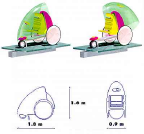Step 10.
| Importance of Minimizing Per Mile Costs in Transit Systems |
| by Douglas J. Malewicki, Inventor of SkyTran and founder of SkyTran, Inc., December 26, 1999. |
| Given a Fixed Budget of $1.35 Billion Dollars: |
|
If the cost of each mile of two way track is: |
Then you could buy this many miles of two way track with your $1.35 billion dollars: |
And your maximum useful HOURLY CAPACITY* in passenger-miles would be: |
Which buys you this much capacity compared to the 35 mile system: |
|
$38.57million |
35 |
252,000 |
100% |
|
$19.29 million |
70 |
504,000 |
200% |
|
$13.50 million |
100 |
720,000 |
286% |
|
$9.00 million |
150 |
1,080,000 |
429% |
|
$6.75 million |
200 |
1,440,000 |
571% |
|
$5.40 million |
250 |
1,800,000 |
714% |
|
$4.50 million |
300** |
2,160,000 |
857% |
|
$3.38 million |
400 |
2,880,000 |
1,143% |
|
$2.70 million |
500 |
3,600,000 |
1,429% |
|
$2.25 million |
600 |
4,032,000 |
1,714% |
|
$1.93 million |
700 |
5,040,000 |
2,000% |
|
$1.69 million |
800 |
5,760,000 |
2,286% |
|
$1.50 million |
900*** |
6,480,000 |
2,571% |
|
$1.35 million |
1000 |
7,200,000 |
2,857% |
| $1.00 million | 1350 | 9,720,000 | 3,857% |
| *HOURLY CAPACITY is calculated for vehicles spaced 2 seconds apart, which are traveling at a steady non-stop 25 mph. It is further assumes that all the vehicles are carrying the full capacity of two people. |
| **This is how many miles of two way Mini Robot Kiddy Train track that could be purchased with $1.35 billion. The ability to build 300 miles instead of just 35 miles for the same budget means 8 complete 35 mile long sets of of Mini Robot Kiddy trains could be networked together to provide much more useful service to community members. This system would have the capacity to provide 216,000 ten mile long trips each hour! |
| ***If you could further lower the Mini Robot Kiddy Train system to below $2 million per mile with clever creative engineering (1/3rd of the estimated conservative $4.5 million cost for a single mile), then capacity benefits and ability to go anywhere at a non-stop 25 mph to any destination in the Greater Phoenix Area becomes a reality! |
Conclusion: This hypothetical Mini Robot Kiddy Train represents a simple, straight forward level of technology that sharp High School students could implement right now. Upon making such an observation, it then becomes 100% safe to predict that 100 years from now the only light rails in existence will be the remaining examples found in nostalgia museums. Even today, light rail is not practical or cost effective. It is on its way out. The only question is merely how SOON will it be rendered fully obsolete and relegated to those museums?
Some alternatives (with comments) to replace the cartoon-like, two seat automated, 25 mph, non-stop, kiddy train vehicles are presented here:
